Pen Cai (盆菜)
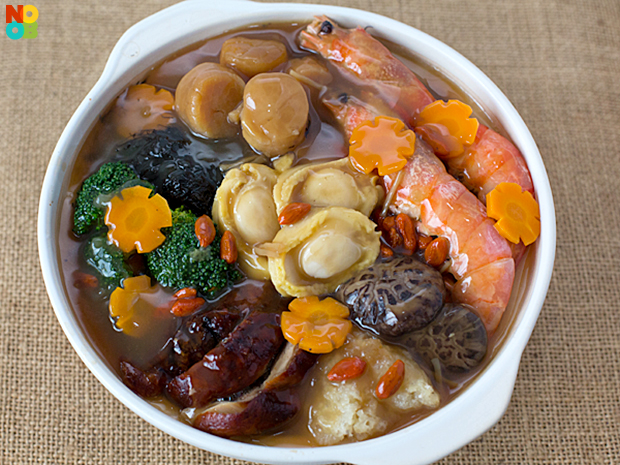
Pen Cai (Poon Choi/Pen Chai/Peng Cai/Big Bowl Feast) literally means “basin vegetables” (盆菜) as it was traditionally served to the Emperor in wooden washbasins during the Song Dynasty (adapted to claypot or casserole in modern times).
See Also:
It is a traditional one-pot Chinese dish of Cantonese origin, and have been a very popular dish in Hong Kong. In recent years, the dish gained immense popularity as a Chinese New Year dish in Singapore. A distinctive feature of Pen Chai is that the ingredients in the claypot are cooked separately, layered and topped with an assortment of seafood delicacies fit for royalty (with luxurious seafood such as abalone and scallops). Eating pen cai signifies abundance and richness in the coming year. I made this pen cai on Sunday for my family’s early Chinese New Year reunion dinner as I will be away during the festive season and I’m happy that it was well-received on the dinner table!
Auspicious symbolisms of Pen Cai ingredients:
- Fat choy (dried moss) sounds like “fatt choi” (striking it rich)
- Prawns (sounds like “ha” in Cantonese) symbolizing laughter (笑 “哈哈”) and happiness
- Green ingredients (broccoli): 青春常驻 (perpetual youthfulness)
- Red items (carrot and wolfberries): 鸿运当头 (good fortune)
- White radish (daikon): 风生水起/步步高升(increasing growth & prosperity)
- Abalone: 年年’包’有余 (increasing abundance). They also looked like ingots (ancient China currency symbolising wealth)
- Golden ingredients (scallops, tau kee, fish maw, tau kwa): 翩地黄金 (abundant wealth)
- Carrots cut to flower shapes: 花开富贵 (blooming success).
Step-by-Step Photos (How to layer the ingredients)
Here’s a step-by-step on how I layer my casserole of treasures. The bottom ingredients are those which can absorb the braising sauce most efficiently. The top layer are the luxury and auspicious items.
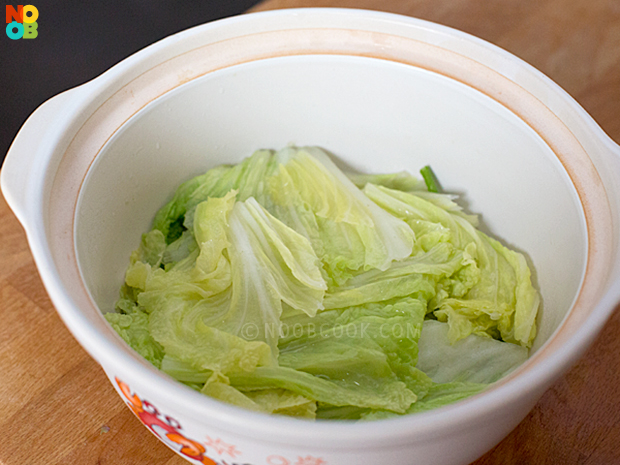
Layer 1: Napa cabbage

Layer 2: Tau kee (beancurd skin)
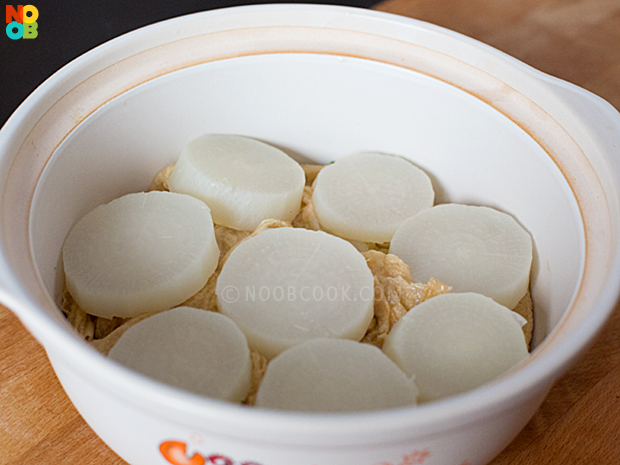
Layer 3: Daikon (white radish)
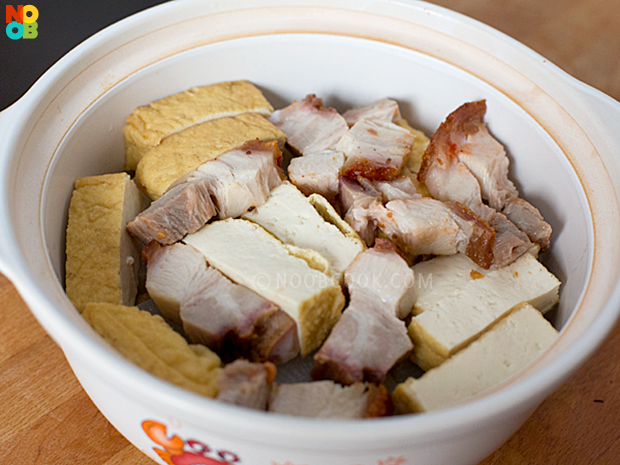
Layer 4: Tau kwa & siu yok
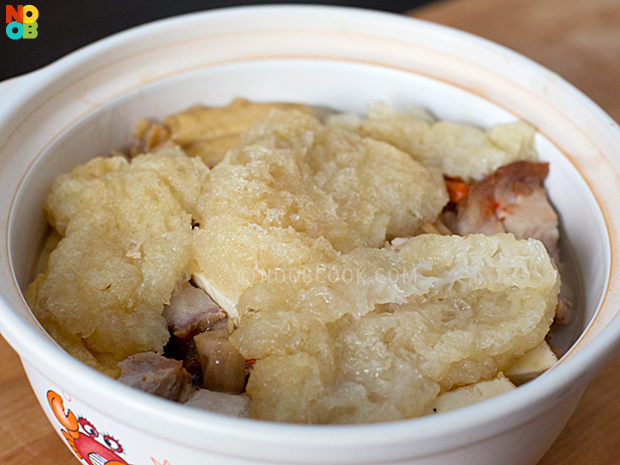
Layer 5: Fish maw (3/4 of it)
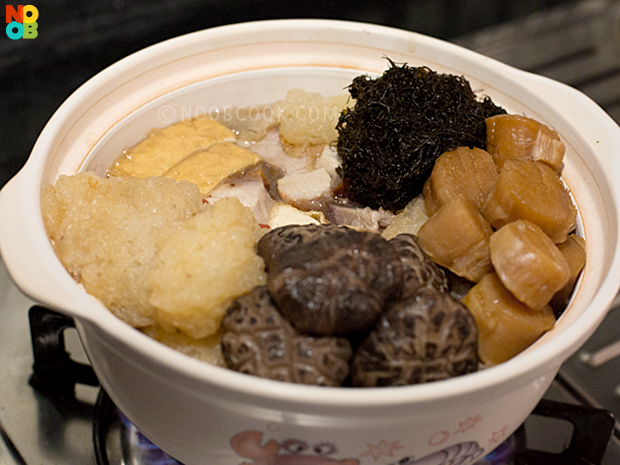
Layer 6: Fat choy, scallops, mushrooms & remaining fish maw. Add gravy until just before the top layer. Cover with lid and simmer for 10 minutes.
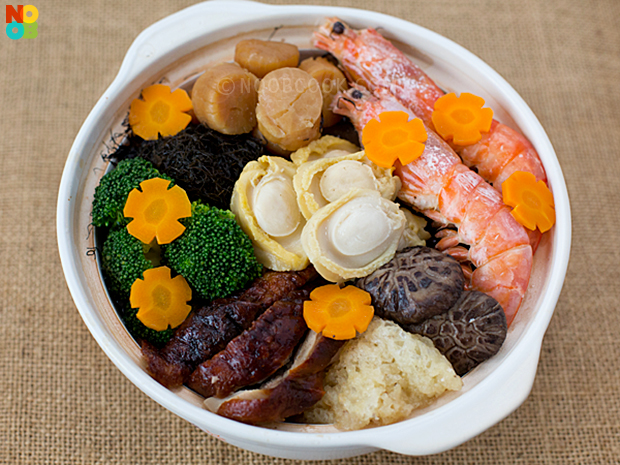
Layer 7: Top with the remaining ingredients (broccoli, abalone, prawns, carrots, roast duck, fish maw).

Layer 8 (last layer): Bring remaining sauce to a simmer, and while the sauce is still bubbling, pour it over the ingredients until filled to the brim. Ready!!!
Even though I used some shortcuts (store-bought fried beancurd & roast meat), it still took me 3 hours to make this dish from start to finish! Although it is tedious and time-consuming to prepare, the method is relatively easy. My cost price for the ingredients was S$100 but I believe the market rate at restaurants is easily S$300, so there is strong justification for all that hard work. The pot is also very filling and can easily be served as a one-dish meal for 6 persons (we had other Chinese New Year dishes to accompany it though), with possibly leftovers for the next day.
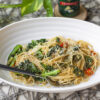
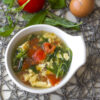
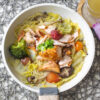
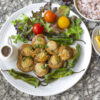
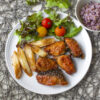
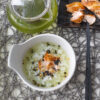
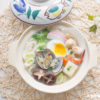



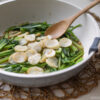

Hello dear,
good day to you. i will like to know what is the size of your casserole for this pen cai ? It is my first time to do this for my family this year but not too sure if a 2.5l of my pot will be enough to fit the ingredients for 7px.
Thank you !!
My casserole is about 1.5-2L. The ingredients are packed very tightly, so your 2.5L should be good.
Hi, this recipe is so detailed and clear! Thanks so much as I am trying Pencai for the first time ◡̈ I would like to add sea cucumber though. How would u prepare and handle that for adding into the pencai? Thanks!